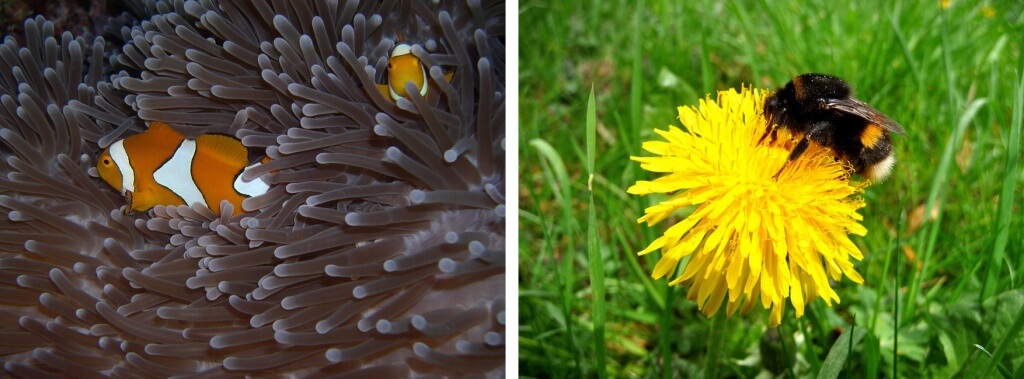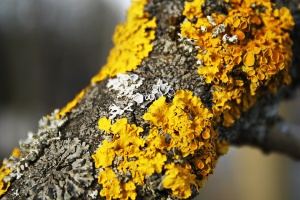In my last article (Go with the flow) you could read about natural material flows and how nutrients and resources continuously cycle through ecosystems. Today I want to follow up on this and tackle another ecologically relevant topic: natural symbiosis. Why are symbiotic relationships so important? What is the success story of this type of organismic interaction? And what could we learn from natural symbiosis in a biomimetic context?

Two colourful examples for natural symbiosis
What is a symbiosis?
In ecological systems, different organisms maintain certain interdependencies to one another – for example a predator-prey relationship or parasitism, which are two examples of one-sided benefit. As a contrast to that, a symbiosis is an interspecific interaction of mutual interest – meaning that both symbionts gain a certain advantage from their interplay. Symbiotic relationships are often evolutionarily optimized with the symbiotic partners becoming highly adapted and also dependent to each other [1]. In the following I want to enlarge upon two examples for natural symbiosis, to clarify its meaning and relevance:
Mycorrhiza
Probably the most important symbiosis in biology – even though it is very inconspicuous on the first glimpse – is the mycorrhiza. It is the interplay of plants and fungus, whereat the fungus hyphae enlarge the surface area of the plant roots to enhance nutrient uptake from the soil and receive photosynthetic products from the plant as ‘reward’ [1,2]. Recent studies also suggest that plants manage to form an underground network via their associated fungi, to communicate with each other over large distances [3].
Lichen

Lichen – a symbiosis of fungi and algae – on a tree bark
Another example for a biological symbiosis is the composite organism lichen: consisting of fungi and algae or cyanobacteria. As in the mycorrhiza, the fungus benefits from this relationship via receiving photosynthetic products from the algae, which on their part get protection from the environment via the fungus filaments and profit from the fungal nutrient uptake. Lichen are extraordinary life forms, existing in various shapes, colours and sizes as well as inhabiting diverse places with varying environmental conditions – all of which being only possible due to the highly functional interplay of the symbionts [4, 5].
The concept of symbiosis in a biomimetic context
Having the biological background in mind, I would like to come back to the answers from the beginning of the article and put the system of a biological symbiotic relationship in a biomimetic context:
-
Why are symbiotic relationships so important?
Nobody can do it all! This is not only valid for us humans, but also for every other natural organisms. Living is always a trade-off – to use the limited amount of resources as efficiently as possible and try to meet all needs as good as possible. This can be quite a challenge or even impossible! Via establishing symbiotic interactions with other organisms, completely new possibilities arise. Suddenly an organism ‘gains’ extra (for example the amount or type of nutrients or water) or is even capable to omit or degenerate structures or features which would cost a lot of energy, because specific requirements are now fulfilled by the symbiotic partner.
-
What is the success story of this type of organismic interaction?
Can we extract the main points of the success of symbiosis? I will try to pin down three aspects, which I consider the most central ones (do you disagree or have other suggestions?) and which will also lead me to ideas for abstraction and a possible biomimetic implementation:
- Specialization (focus on several effective features instead of trying to do it all)
- The willingness to provide something in order to gain something as a reward
- The ability of co-evolution – being able to develop further and optimize the mutual cooperation with the goal to achieve a more efficient interaction
-
What could we learn from natural symbiosis in a biomimetic context?
Are we able to implement or at least learn from these aspects for ameliorating interactions we have to deal with? For example industrial supply chains where partners are highly dependent on each other or other kinds of cooperation, division of labour expertise or simply working groups?
In the last decade, the concept of ‘industrial symbiosis’ has been introduced by economists as a way to improve industrial processes with the concepts of symbiosis. Marian R. Chertow, as one of the leading researchers of industrial ecology (a topic where ‘industrial symbiosis’ can be embedded into) states that industrial symbiosis ‘[…] engages traditionally separate industries in a collective approach to competitive advantage involving physical exchange of materials, energy, water, and/or by-products […]’ [6]. To realize this concept, some conditions have to be considered such as geographic proximity of the partners [6] or the cooperation of at least three entities as well as the exchange of at least two different resources [7].
Are these really new ideas – or just ‘old’ statements refreshed in a more modern context? Can this be called a biomimetic approach?
Can a complex system from biology, such as a symbiotic relationship, be really implemented in an industrial environment? Is it maybe too difficult or requires too many abstraction steps?
References:
[1] Campbell, N. A., Reece, J. B. and Markl, Jürgen (Hg.) [2006] Biologie (6.Auflage) München, Pearson Studium[2] Smith, Sally E. and Read, David [2008] Mycorrhizal symbiosis (Third Edition) Elsevier Ltd.
[3] Wohlleben, Peter [2015] Das geheime Leben der Bäume: Was sie fühlen, wie sie kommunizieren – die Entdeckung einer verborgenen Welt (1.Ausgabe) Ludwig Buchverlag
[4] https://en.wikipedia.org/wiki/Lichen
[5] Upreti, Dalip Kumar, Divakar, Pradeep K., Shukla, Vertika and Bajpai, Rajesh [2015] Recent Advances in Lichenology, Modern Methods and Approaches in Lichen Systematics and Culture Techniques (Volume 2) Springer India
[6] Chertow, Marian R. [2000] Industrial Symbiosis: Literature and Taxonomy, Annu. Rev. Energy Environ. 25: 313-37
[7] Chertow, Marian R. [2007] “Uncovering” Industrial Symbiosis, Journal of Industrial Economy 11 (1): 11-30



